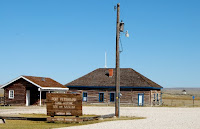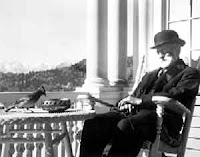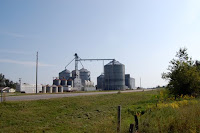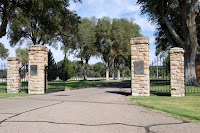 Setting out from Casper, our first stop on the Oregon Trail is Fort Caspar. This old post began as a trading post and toll bridge built by Louis Guinard in 1859. It also served as an overnight stage stop, Pony Express mail stop and telegraph office. In 1861, volunteer cavalry were ordered to Guinard’s Bridge to guard against the increasingly frequent Indian Raids. The following year, the trading post became a one-company military post and was renamed Platte Bridge Station. Troops enlarged and rebuilt the fort in 1866, but when the the Union Pacific Railroad and the new transcontinental telegraph reached Cheyenne, Wyoming in the fall of 1867, migration along the the Oregon-California-Mo
Setting out from Casper, our first stop on the Oregon Trail is Fort Caspar. This old post began as a trading post and toll bridge built by Louis Guinard in 1859. It also served as an overnight stage stop, Pony Express mail stop and telegraph office. In 1861, volunteer cavalry were ordered to Guinard’s Bridge to guard against the increasingly frequent Indian Raids. The following year, the trading post became a one-company military post and was renamed Platte Bridge Station. Troops enlarged and rebuilt the fort in 1866, but when the the Union Pacific Railroad and the new transcontinental telegraph reached Cheyenne, Wyoming in the fall of 1867, migration along the the Oregon-California-Mo rmon Pioneer Trail dramatically began to wane. The army then began to establish new installations to protect the railroad route across southern Wyoming. On October 19, 1867, orders were issued to abandon Fort Caspar and troops and materials, including some of the buildings were transferred to Fort Fetterman, Wyoming. Almost immediately after the troops were gone, the Indians burned the buildings and the bridge. Today, however, the site, listed on the National Register of Historic Places is rebuilt and features a museum.
rmon Pioneer Trail dramatically began to wane. The army then began to establish new installations to protect the railroad route across southern Wyoming. On October 19, 1867, orders were issued to abandon Fort Caspar and troops and materials, including some of the buildings were transferred to Fort Fetterman, Wyoming. Almost immediately after the troops were gone, the Indians burned the buildings and the bridge. Today, however, the site, listed on the National Register of Historic Places is rebuilt and features a museum. Next, we're on down the road to Fort Fetterman. Off the main road, we follow a well-marked gravel road some seven miles to the site. Alas, when we get there, it's closed for the season. Now, why is it that they couldn't have indicated on one of the other half dozen signs along the way that it was closed. Love Wyoming, but we experienced signage problems, just like this in a lot of places. Anyway, we're there, so snap a few pictures and we're on our way again.
Next, we're on down the road to Fort Fetterman. Off the main road, we follow a well-marked gravel road some seven miles to the site. Alas, when we get there, it's closed for the season. Now, why is it that they couldn't have indicated on one of the other half dozen signs along the way that it was closed. Love Wyoming, but we experienced signage problems, just like this in a lot of places. Anyway, we're there, so snap a few pictures and we're on our way again.  Continuing along the historic path, we stop at a number of historic markers before making our way to Oregon Trail Ruts State Historic Site near Guernsey, Wyoming. The wagon ruts of the Oregon Trail on the North Platte River were winding up towards South Pass. Wagon wheels, draft animals, and people wore down the trail about two to six feet into a sandstone ridge during its heavy usage from 1841-1869. The half-mile stretch is "unsurpassed" and is the best-preserved of Oregon Trail ruts anywhere along the trail. It was declared a National Historic Landmark in 1966.
Continuing along the historic path, we stop at a number of historic markers before making our way to Oregon Trail Ruts State Historic Site near Guernsey, Wyoming. The wagon ruts of the Oregon Trail on the North Platte River were winding up towards South Pass. Wagon wheels, draft animals, and people wore down the trail about two to six feet into a sandstone ridge during its heavy usage from 1841-1869. The half-mile stretch is "unsurpassed" and is the best-preserved of Oregon Trail ruts anywhere along the trail. It was declared a National Historic Landmark in 1966. We then make the short trip over to Register Cliff, located nearby. Also referred to as Sand Point Station, the cliff is natural sandstone monument rising one hundred feet from the valley floor of the North Platte River. Despite erosion by wind and water it remains very much as travelers on the Oregon Trail saw it more than 100 years ago. One of three main sites along the Oregon Trail where emigrants left inscriptions, emigrants camped here along the banks of the North Platte River and etched their names into the soft sandstone cliff. Many of the inscriptions were made during the peak years of travel on the trail in the 1840s and 1850s. Even earlier, however, as far back as 1829, trappers and traders passing through carved their names into the rock. A small trading post was located near the cliff. In 1861, it was turned into a Pony Express stop, and later a stage station. A walkway and informative sign at the base of the cliff enable the visitor to learn more about this historic site.
We then make the short trip over to Register Cliff, located nearby. Also referred to as Sand Point Station, the cliff is natural sandstone monument rising one hundred feet from the valley floor of the North Platte River. Despite erosion by wind and water it remains very much as travelers on the Oregon Trail saw it more than 100 years ago. One of three main sites along the Oregon Trail where emigrants left inscriptions, emigrants camped here along the banks of the North Platte River and etched their names into the soft sandstone cliff. Many of the inscriptions were made during the peak years of travel on the trail in the 1840s and 1850s. Even earlier, however, as far back as 1829, trappers and traders passing through carved their names into the rock. A small trading post was located near the cliff. In 1861, it was turned into a Pony Express stop, and later a stage station. A walkway and informative sign at the base of the cliff enable the visitor to learn more about this historic site. Continuing along, our next stop is Fort Laramie, which I have been looking forward to all day. Fort Laramie was located at the Crossroads of a Nation Moving West. In 1834, where the Cheyenne and Arapaho traveled, traded and hunted, a fur trading post was created. Though it was not a military fort at first, it was called Fort William and soon became known as a place of safety, as settlers moved across the continent. By the 1840s, wagon trains rested and re-supplied here, bound for Oregon, California, and Utah.
Continuing along, our next stop is Fort Laramie, which I have been looking forward to all day. Fort Laramie was located at the Crossroads of a Nation Moving West. In 1834, where the Cheyenne and Arapaho traveled, traded and hunted, a fur trading post was created. Though it was not a military fort at first, it was called Fort William and soon became known as a place of safety, as settlers moved across the continent. By the 1840s, wagon trains rested and re-supplied here, bound for Oregon, California, and Utah. In 1841, Fort John was constructed, replacing the original wooden stockade of Fort William. Constructed of adobe brick, Fort John stood on a bluff overlooking the Laramie River. It was named for John Sarpy, a partner in the American Fur Company, but was more commonly called Fort Laramie by employees and travelers.
In 1841, Fort John was constructed, replacing the original wooden stockade of Fort William. Constructed of adobe brick, Fort John stood on a bluff overlooking the Laramie River. It was named for John Sarpy, a partner in the American Fur Company, but was more commonly called Fort Laramie by employees and travelers. Fort Laramie, the military post, was founded in 1849 when the army purchased the old Fort John for $4000, and began to build a military outpost along the Oregon Trail. For many years, the Plains Indians and the travelers along the Oregon Trail had coexisted peacefully. As the numbers of emigrants increased, however, tensions between the two cultures began to develop.
Fort Laramie, the military post, was founded in 1849 when the army purchased the old Fort John for $4000, and began to build a military outpost along the Oregon Trail. For many years, the Plains Indians and the travelers along the Oregon Trail had coexisted peacefully. As the numbers of emigrants increased, however, tensions between the two cultures began to develop.In the 1850s, one of the main functions of the troops stationed at the fort was patrolling and maintaining the security of a lengthy stretch of the Oregon Trail. The 1860s brought a different type of soldier to Fort Laramie. After the beginning of the Civil War, most regular army troops were withdrawn to the East to participate in that conflict, and the fort was garrisoned by state volunteer regiments, such as the Seventh Iowa and the Eleventh Ohio. The stream of emigrants along the Oregon Trail began to diminish, but the completion of the transcontinental telegraph line in 1861 brought a new responsibility to the soldiers.
 By the end of the 1880s, the Army recognized that Fort Laramie had served its purpose. Many important events on the Northern Plains had involved the Fort, and many arteries of transport and communication had passed through it. Perhaps the most important artery, however, the Union Pacific Railroad, had bypassed it to the South. In March of 1890, troops marched out of Fort Laramie for the last time. The land and buildings that comprised the Fort were sold at auction to civilians.
By the end of the 1880s, the Army recognized that Fort Laramie had served its purpose. Many important events on the Northern Plains had involved the Fort, and many arteries of transport and communication had passed through it. Perhaps the most important artery, however, the Union Pacific Railroad, had bypassed it to the South. In March of 1890, troops marched out of Fort Laramie for the last time. The land and buildings that comprised the Fort were sold at auction to civilians.Today, the old post is a National Historic Site, preserving 11 restored buildings, such as “Old Bedlam,” the post headquarters and officers’ quarters built in 1849; the cavalry barracks built in 1874; Sutler’s Store; a stone guardhouse; and a bakery. A museum exhibits artifacts of the Northern Plains. The historic site, which encompasses 833 acres is administered by the National Park Service.















































